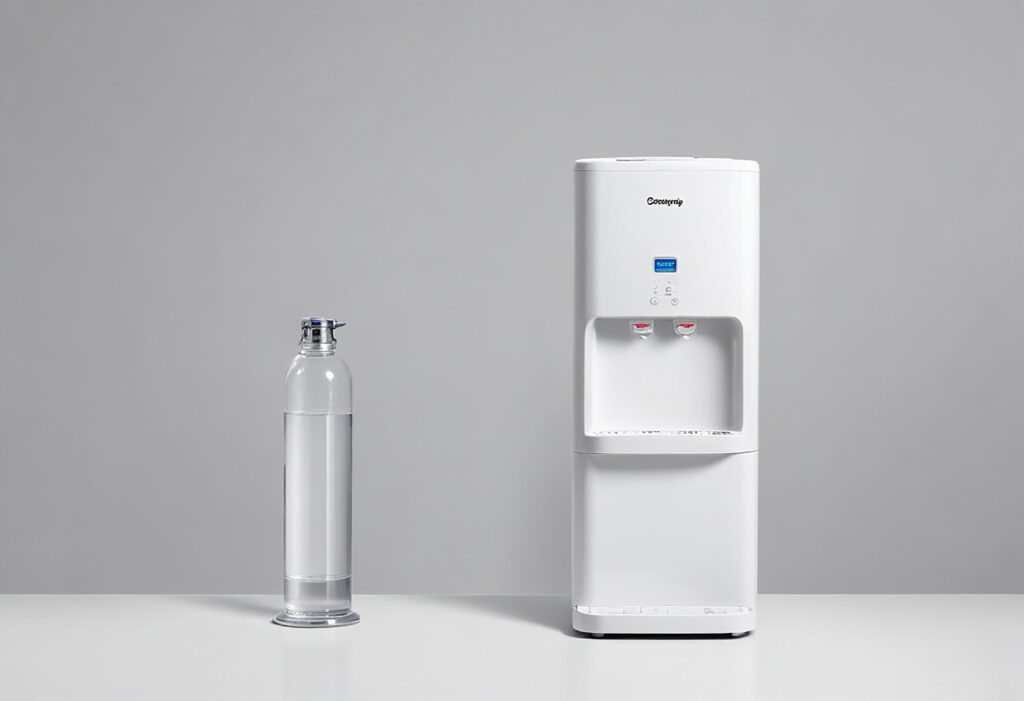Water dispensers have become a staple in homes and offices worldwide, offering easy access to hydration. But their journey from simple, gravity-fed systems to today’s smart technology is a fascinating tale of innovation. This article traces the evolution of water dispensers, highlighting key advancements such as filtration systems, touchless operation, and the integration of smart technology.
Early Beginnings: The Gravity-Feed Systems
The concept of a water dispenser dates back to ancient civilizations. Early forms of water dispensers were simple clay or wooden containers that allowed gravity to feed water into smaller vessels. These rudimentary systems were primarily found in public spaces, such as marketplaces or communal areas, where people gathered to fill their containers.
As time progressed, the need for more convenient and sanitary solutions emerged. In the late 19th century, the first mechanical water coolers were developed. These devices used ice to cool water, making it more palatable, especially in warmer climates. However, these early coolers required significant maintenance and effort to keep them functional, limiting their widespread adoption.
The Rise of Bottled Water Dispensers
The introduction of bottled water in the early 20th century revolutionized the way people accessed drinking water. Bottled water dispensers became popular in homes and offices, providing a convenient way to enjoy clean water without the need for constant refilling.
These dispensers typically featured a large bottle mounted upside down, allowing gravity to feed water into a spigot for easy dispensing. While practical, this design had its drawbacks, including the environmental impact of single-use plastic bottles and the hassle of replacing heavy bottles.
Advancements in Filtration Technology
As concerns about water quality grew, innovations in filtration technology began to shape the water dispenser market. In the 1970s and 1980s, reverse osmosis and activated carbon filters became widely available, enabling consumers to enjoy purified water directly from the tap.
Bottleless water dispensers emerged as a solution to the environmental issues posed by bottled water. These systems connect directly to a building’s plumbing and incorporate advanced filtration systems, providing unlimited access to filtered water without the need for bottles. This not only reduces plastic waste but also ensures a consistent supply of fresh water.
Touchless Operation: A Step Towards Hygiene
The COVID-19 pandemic brought hygiene to the forefront of public consciousness, leading to a surge in demand for touchless water dispensers. These devices utilize motion sensors or foot pedals to dispense water without physical contact, minimizing the risk of germ transmission.
Touchless technology has been adopted in both home and office settings, featuring sleek designs that enhance user experience while prioritizing hygiene. Additionally, many modern touchless dispensers come equipped with UV-C light technology that helps sanitize the water, further ensuring its safety.
Smart Technology: The Future of Water Dispensers
The latest phase in the evolution of water dispensers is the integration of smart technology. Smart water dispensers can connect to Wi-Fi and be controlled via smartphone apps, offering users an unprecedented level of convenience and customization.
Key Features of Smart Water Dispensers
- Remote Monitoring and Control: Users can monitor their water consumption, set hydration goals, and receive alerts when it’s time to replace filters or when water levels are low.
- Customizable Temperature Settings: Many smart dispensers allow users to set their preferred water temperature, catering to personal tastes whether for cold, warm, or hot beverages.
- Integration with Smart Home Systems: Some models are compatible with voice-activated assistants like Amazon Alexa or Google Assistant, enabling users to dispense water with simple voice commands.
- Water Quality Monitoring: Advanced sensors can detect and report on water quality, alerting users to potential contaminants or the need for filter changes.
- Sustainability Features: Smart dispensers often include energy-saving modes and notifications to help users reduce water waste and enhance sustainability efforts.
The Environmental Impact of Modern Water Dispensers
As the focus on sustainability grows, modern water dispensers are designed with eco-friendliness in mind. Bottleless systems significantly reduce plastic waste and are often made from recyclable materials. Many manufacturers are also implementing energy-efficient designs to minimize their overall carbon footprint.
Furthermore, advancements in water filtration technology contribute to better resource management. By providing clean drinking water directly from the tap, these systems help reduce the reliance on bottled water, promoting a more sustainable lifestyle.
Challenges and Considerations
Despite the many advancements, there are still challenges to consider with modern water dispensers. The initial cost of smart and bottleless dispensers can be higher than traditional bottled systems. Additionally, installation may require plumbing modifications, which can be a barrier for some users.
Regular maintenance is also essential to ensure optimal performance. Filters need to be replaced periodically, and the dispensers themselves require cleaning to prevent bacteria buildup. However, many manufacturers provide easy-to-follow maintenance guidelines and reminders through their connected apps.
Conclusion
The evolution of water dispensers has transformed the way we access and consume water. From basic gravity-fed systems to advanced smart technology, each advancement reflects changing consumer needs and technological capabilities. As we move forward, the focus will likely continue to shift toward sustainability and health, with innovations that not only enhance convenience but also contribute to a healthier planet.
As water dispensers become more integrated into our daily lives, their role in promoting hydration and improving water quality will remain crucial. Whether in homes, offices, or public spaces, these devices will continue to evolve, ensuring that access to clean water remains a priority for all.
